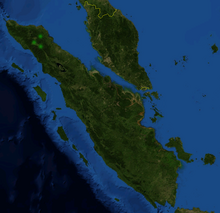Nepenthes angasanensis
| Nepenthes angasanensis | |
|---|---|

| |
| Nepenthes angasanensis holotype (Salmon & Maulder 234372). | |
Conservation status
| |
| Scientific classification | |
| Kingdom: | Plantae |
| Clade: | Tracheophytes |
| Clade: | Angiosperms |
| Clade: | Eudicots |
| Order: | Caryophyllales |
| Family: | Nepenthaceae |
| Genus: | Nepenthes |
| Species: | N. angasanensis
|
| Binomial name | |
| Nepenthes angasanensis , , & (1999)[2]
| |

| |
| Distribution of N. angasanensis. | |
| Synonyms | |
Nepenthes angasanensis /nɪˈpɛnθiːz ˌæŋɡəsəˈnɛnsɪs/ is a tropical pitcher plant species endemic to Sumatra, where it grows at an altitude of 1,400 metres (4,600 ft) to 3,100 metres (10,200 ft) above sea level.[1][7] The status of this taxon is controversial as it is similar in morphology to N. mikei and N. tobaica. It has even been suggested that the taxon might represent a natural hybrid between N. densiflora and N. tobaica.[8]
The specific epithet refers to , from which the type specimen was collected.[2] No forms or varieties of N. angasanensis have been described.
Taxonomy[]
| Character | N. angasanensis | N. mikei | N. tobaica |
|---|---|---|---|
| Habit | Produces offshoots from underground rhizomes | No rhizomes | No rhizomes |
| Spur | Forked | Fasciculate | Filiform |
| Inner margin of peristome | Teeth to 1.5 millimetres (0.06 in) to 2 millimetres (0.08 in) long | Teeth to 0.2 millimetres (0.01 in) to 0.4 millimetres (0.02 in) long | Teeth < 0.2 millimetres (0.01 in) |
| Stem cross section | Cylindrical | Cylindrical | Cylindrical to obtusely triangular |
| Bracteoles | Sometimes near base of lowest pedicel only | Half way up every pedicel | At base or slightly below pedicel attachment, few |
| Pitcher glands | 300 / cm² (1900 per sq in) | 150-180 / cm² (1000 to 1200 per sq in) | 200-250 / cm² (1300 to 1600 per sq in) |
| Pedicels | 1-flowered | 1-flowered | 2-flowered |
| Inflorescence (female) | 5.5 centimetres (2 in) to 12.5 centimetres (5 in) long, 9-17 flowers | 4 centimetres (2 in) to 8 centimetres (3 in) long, 4-10 flowers | 19.5 centimetres (8 in) to 40 centimetres (16 in) long, 30-50 flowers |
In 2001, Charles Clarke performed a cladistic analysis of the Nepenthes species of Sumatra and Peninsular Malaysia using 70 morphological characteristics of each taxon. The following is a portion of the resultant cladogram, showing part of "Clade 6". The sister pair of N. angasanensis and N. mikei has 79% support.[9]
| ||||||||||||||||||||||||||||
Natural hybrids[]
The following natural hybrids involving N. angasanensis have been recorded.
- N. angasanensis × N. densiflora[9]
References[]
- ^ Jump up to: a b Clarke, C.M. (2018). "Nepenthes angasanensis". IUCN Red List of Threatened Species. 2018: e.T39642A143958899. Retrieved 18 April 2020.
- ^ Jump up to: a b Salmon, B. & R. Maulder 1999. Notes on Nepenthes from Northern Sumatra. Carnivorous Plant Newsletter 28(1): 14–18.
- ^ Jebb, M.H.P. & M.R. Cheek 1997. A skeletal revision of Nepenthes (Nepenthaceae). Blumea 42(1): 1–106.
- ^ Cheek, M.R. & M.H.P. Jebb 2001. Nepenthaceae. Flora Malesiana 15: 1–157.
- ^ Danser, B.H. 1940. A new Nepenthes from Sumatra. Bulletin du Jardin Botanique de Buitenzorg, Série III, 16: 268–271.
- ^ (in Indonesian) Tamin, R. & M. Hotta 1986. Nepenthes di Sumatera: The genus Nepenthes of the Sumatra Island. In: M. Hotta (ed.) Diversity and Dynamics of Plant Life in Sumatra: Forest Ecosystem and Speciation in Wet Tropical Environments. Part 1: Reports and Collection of Papers. Kyoto University, Kyoto. pp. 75–109.
- ^ McPherson, S.R. & A. Robinson 2012. Field Guide to the Pitcher Plants of Sumatra and Java. Redfern Natural History Productions, Poole.
- ^ Schlauer, J. N.d. Nepenthes angasanensis. Carnivorous Plant Database.
- ^ Jump up to: a b Clarke, C.M. 2001. Nepenthes of Sumatra and Peninsular Malaysia. Natural History Publications (Borneo), Kota Kinabalu.
- Clarke; et al. (2000). "Nepenthes angasanensis". IUCN Red List of Threatened Species. 2000. Retrieved 11 May 2006.
- Hernawati & P. Akhriadi 2006. A Field Guide to the Nepenthes of Sumatra. PILI-NGO Movement, Bogor.
External links[]
- Photographs of N. angasanensis at the Carnivorous Plant Photofinder
- IUCN Red List least concern species
- Carnivorous plants of Asia
- Nepenthes
- Endemic flora of Sumatra
- Plants described in 1999
